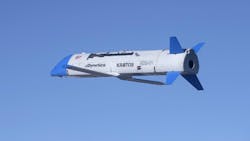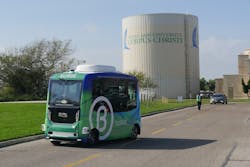Air-recoverable military drone successfully completes testing milestone
In this week’s roundup from the Association for Unmanned Vehicle Systems International, which highlights some of the latest news and headlines in unmanned vehicles and robotics, the Defense Advanced Research Projects Agency (DARPA) gives an update on an experimental drone that can be recovered in the air, residents of Illinois, USA embrace drone flights, and Texas A&M University-Corpus Christi begins automated passenger shuttle services.
Dynetics' X-61A Gremlins Air Vehicle completes first flight
Dynetics, the performer for the Defense Advanced Research Projects Agency (DARPA) Gremlins program, has announced that in Nov. 2019, it successfully flew its X-61A Gremlins Air Vehicle (GAV) for the first time at Dugway Proving Ground near Salt Lake City, Utah.
Testing operations involved one captive-carry mission aboard a TBM Inc. C-130A and an airborne launch and free flight of the X-61A, which lasted one hour and 41 minutes.
Some of the test objectives included demonstrating a successful launch of the GAV from the C-130, collecting data on GAV subsystem operation and performance, and demonstrating the flight termination and ground (parachute) recovery of the GAV (demonstration system only - not part of the operational system).
According to Dynetics, the X-61A flew the way it was supposed to with no anomalies and achieved all of its test objectives that relate to the operational system. The engine was shut down at the end of the mission, and a drogue chute successfully deployed to terminate flight, but due to a failure to extract the main chute, the vehicle was lost during the ground recovery sequence.
“This flight marks a historic milestone for Dynetics and the Gremlins program,” says Tim Keeter, Dynetics Gremlins program manager.
“The GAV flew beautifully and our command and control system kept us in total control of the GAV for the entire flight. The loss of our vehicle validates our decision to build five GAVs for Phase 3; we still have four remaining. Overall, I am proud to see all the hard work pay off and we are excited to continue this momentum towards the first airborne recovery in early 2020.”
The Gremlins program is managed out of DARPA’s Tactical Technology Office (TTO). The main goal of the Gremlins is to “accelerate the ability to perform aerial launch and recovery of volley quantities of low-cost, reusable” UAS, Dynetics explains. Dynetics adds that the Nov. 2019 test is the next step toward the completion of the program's Phase 3 demonstration objectives, which include a final flight test to demonstrate the ability to recover four GAVs in less than 30 minutes.
Last year was a very successful year for the Gremlins team, as the team reached several milestones throughout the course of the year. In February, a successful flight test of the docking system was conducted. In March, the Gremlins team performed its first flight of the GAV avionics system, installed onboard the Calspan Variable Stability System (VSS) Lear Jet as a dress rehearsal for the Nov. 2019 flight. The team also received a U.S. Air Force-assigned X-61A designation in August.
“This flight test validates all the engineering design work, analysis, and ground testing we have performed in the past two and a half years,” says Brandon Hiller, chief engineer for the X-61A.
“We have a lot of confidence in the vehicle's performance and overall design going forward, and the telemetry data from the flight compares exceptionally well to our modeling predictions. Our team has done a superb job to achieve first flight of this unique aircraft in such a short amount of time, and we are eager to get this new capability into the hands of the DoD.”
Central Illinois residents embrace drones
Central Illinois residents are using UAS for a variety of purposes, including to assist with conservation issues, monitor crop growth and agricultural operations, and capture the community from a unique perspective.
One of the area’s primary users of drone technology is Jacques Nuzzo, the program director of the Illinois Raptor Center. Recently, Nuzzo used a UAS to capture images of invasive Asian Carp when they invaded the area below the Lake Decatur dam in July 2019. Nuzzo sent the images to the Illinois Department of Natural Resources, and soon, a rapid response team was on the scene.
“It was at that moment I realized I was not a wildlife photographer,” Nuzzo says via the Herald & Review. “I was a conservation photographer.”
An early adopter of UAS, Nuzzo became inspired to use the technology after viewing a Discovery Channel segment on UAS approximately 15 years ago. His goal at the time was to capture close-up views of nests and other animal habitats. In 2006, Nuzzo purchased his first UAS, a 350 QX drone, and his collection of UAS has grown steadily ever since.
Nuzzo found no shortage of use cases for drones over the years. In Sept. 2014, the Illinois Environmental Protection Agency reached out to Nuzzo for assistance in the aftermath of an oil spill in Springfield’s Washington Park lagoon. Using the aerial photos that Nuzzo captured of the spill, the EPA was able to identify the oil-catching booms weren’t properly positioned, so the booms were redeployed and a majority of the spilled oil was contained.
According to Nuzzo, the Illinois Raptor Center was the first agency in the country that was legally authorized to direct a drone over an eagle's nest. After a nesting bald eagle was shot in McLean County in March 2015, a federal investigation—which is still open today—was launched. Nuzzo contacted the U.S. Fish and Wildlife Services to request authorization to fly a UAS over the nest to check the welfare of the chicks inside. Nuzzo notes that the process had to be quick.
“If you have a nesting bird of prey, they don’t like these things near their nests at all,” Nuzzo says.
Another industry that has embraced this technology in Illinois is the real estate community in Decatur, Illinois, which is using the technology to enhance the marketing of its products.
Tom Brinkoetter, the owner of Brinkoetter Realtors, obtained his UAS operating license a month after they were allowed for business purposes. Brinkoetter and Realtor Doug Brown decided to operate the UAS themselves instead of hiring a UAS pilot.
“It gives people a different perspective on the property that we’re marketing,” Brinkoetter says. “It’s more of an experience of putting people at that property without actually going to the property to generate interest to go there.”
According to Tim Stock, executive vice president of the Macon County Farm Bureau, the farming community is also embracing UAS technology, as they have proven to make tedious tasks a lot simpler.
“Instead of walking those fields, they can do it all with a drone and evaluate a field much faster,” Stock says. “These drones can be used for a chemical application instead of a person getting out. It's something that's being looked at more and more. The size of these things continue to grow, just like farm equipment does.”
Corpus Christi Regional Transportation Authority introduces autonomous shuttle at Texas A&M University-Corpus Christi
During a VIP event at Texas A&M University-Corpus Christi, the Corpus Christi Regional Transportation Authority (CCRTA) introduced the first autonomous shuttle in the region.
According to CCRTA, the shuttle service is one of the first in the nation to operate on a complex route that is exposed not only to vehicular traffic, but also foot traffic.
“This new shuttle is one more way the Island University continues to lead in cutting edge innovation and the use of new technology,” says Dr. Kelly M. Miller, Texas A&M-Corpus Christi president.
“We are excited to partner with CCRTA on this project that will enhance campus life and show how research turns into usable innovations.”
Known as SURGE, the shuttle being used for the service is EasyMile’s EZ10 generation III. CCRTA contractor MV Transportation Inc. will operate the shuttle, which is making its debut in North America through this service.
The shuttle arrived back in Nov. 2019 to map and test the route. Meanwhile, employees and first responders conducted emergency operations training. The vehicle and route will not be on any public streets; instead, they will service the university which is currently facing challenges of limited parking and traffic congestion due to its continued growth.
“Our number one priority with all of our transportation services is safety,” says Jorge Cruz-Aedo, CCRTA chief executive officer. “We want to ensure our riders and community that riding the autonomous shuttle is safe.”
CCRTA says that individuals can use its transportation to arrive on campus before connecting to the shuttle. The shuttle can hold up to 12 riders, and it is equipped with a built-in access ramp for those with disabilities.
Share your vision-related news by contacting Dennis Scimeca, Associate Editor, Vision Systems Design
SUBSCRIBE TO OUR NEWSLETTERS

